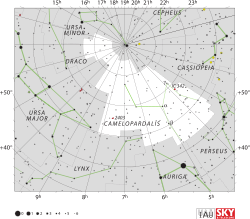Beta Camelopardalis
Beta Camelopardalis (β Camelopardalis, förkortat Beta Cam, β Cam), som är stjärnans Bayer-beteckning, är en ensam stjärna i den södra delen av stjärnbilden Giraffen. Den har en skenbar magnitud på +4,02[2], är synlig för blotta ögat där ljusföroreningar ej förekommer och är den ljusaste stjärna i stjärnbilden. Baserat på parallaxmätningar i Hipparcos-uppdraget på 3,7[1] mas befinner den sig på ca 870 ljusårs avstånd från solen.
| Beta Camelopardalis | |
 | |
| Observationsdata Epok: J2000 | |
|---|---|
| Stjärnbild | Giraffen |
| Rektascension | 05t 03m 25,08963s[1] |
| Deklination | +60° 26′ 32,0895″[1] |
| Skenbar magnitud () | +4,02[2] |
| Stjärntyp | |
| Spektraltyp | G1Ib - IIa[3] |
| U–B | +0,62[2] |
| B–V | +0,49[2] |
| R–I | +0,49[2] |
| Variabeltyp | Förmörkelsevariabel av Algol-typ(EA)[4] |
| Astrometri | |
| Radialhastighet () | -190[5] km/s |
| Egenrörelse (µ) | RA: -6,50[1] mas/år Dek.: -14,15[1] mas/år |
| Parallax () | 3,74 ± 0,21[1] |
| Avstånd | 870 ± 50 lå (270 ± 20 pc) |
| Absolut magnitud () | -3,1[6] |
| Detaljer | |
| Massa | 6,5[3] M☉ |
| Radie | 58 ± 13[7] R☉ |
| Luminositet | 1 592[8] L☉ |
| Temperatur | 5 300[3] K |
| Metallicitet | -0,06[9] |
| Vinkelhastighet | 11,7 km/s[10] |
| Ålder | 63[3] miljoner år |
| Andra beteckningar | |
| β Cam, 10 Camelopardalis, BD+60° 856, FK5 182, HD 31910, HIP 23522, HR 1603, SAO 13351, ADS 3615 A, WDS J05034+6027 | |
Egenskaper
redigeraBeta Camelopardalis är en gul superjättestjärna av spektralklass G1 Ib-IIa.[3] Den har en massa som är ca 6,5[3] gånger solens massa, en radie som är ca 58[7] gånger solens radie och avger ca 1 600[8] gånger mer energi än solen från dess fotosfär vid en effektiv temperatur på ca 5 300 K.[3]
Beta Camelopardalis är en förmörkelsevariabel av Algol-typ med okänd amplitud på sina variationer.[4][11]
Beta Camelopardalis har två visuella[12] följeslagare: en stjärna av spektralklass A5 av 7:e magnituden med en vinkelseparation på 84 bågsekunder och en stjärna av 12:e magnituden separerad med 15 bågsekunder.[13] Den roterar med en projicerad rotationshastighet på 11,7 km/s,[10] vilket är en ovanligt snabb rotation för en utvecklad stjärna av denna typ. En möjlig förklaring är att det kan ha uppslukat en närliggande jätteplanet, som en het Jupiter.[14]
Referenser
redigera- Den här artikeln är helt eller delvis baserad på material från engelskspråkiga Wikipedia, Beta Camelopardalis, 14 februari 2019.
Noter
redigera- ^ [a b c d e f] Van Leeuwen, F. (2007). "Validation of the new Hipparcos reduction". Astronomy and Astrophysics. 474 (2): 653. arXiv:0708.1752. Bibcode:2007A&A...474..653V. doi:10.1051/0004-6361:20078357.
- ^ [a b c d e] Ducati, J. R. (2002). "VizieR Online Data Catalog: Catalogue of Stellar Photometry in Johnson's 11-color system". CDS/ADC Collection of Electronic Catalogues. 2237. Bibcode:2002yCat.2237....0D.
- ^ [a b c d e f g] Lyubimkov, Leonid S.; Lambert, David L.; Korotin, Sergey A.; Rachkovskaya, Tamara M.; Poklad, Dmitry B. (2015). "Carbon abundance and the N/C ratio in atmospheres of A-, F- and G-type supergiants and bright giants". Monthly Notices of the Royal Astronomical Society. 446 (4): 3447. arXiv:1411.2722. Bibcode:2015MNRAS.446.3447L. doi:10.1093/mnras/stu2299.
- ^ [a b] ”NSV 16223” (på engelska). The International Variable Star Index. AAVSO – American Association of Variable Star Observers. https://www.aavso.org/vsx/index.php?view=detail.top&oid=54658. Läst 18 augusti 2016.
- ^ Gontcharov, G. A. (2006). "Pulkovo Compilation of Radial Velocities for 35 495 Hipparcos stars in a common system". Astronomy Letters. 32 (11): 759. arXiv:1606.08053. Bibcode:2006AstL...32..759G. doi:10.1134/S1063773706110065.
- ^ Gray, David F.; Pugh, Teznie (2012). "The Third Signature of Granulation in Bright-giant and Supergiant Stars". The Astronomical Journal. 143 (4): 92. Bibcode:2012AJ....143...92G. doi:10.1088/0004-6256/143/4/92.
- ^ [a b] Van Belle, G. T.; et al. (2009). "Supergiant temperatures and linear radii from near-infrared interferometry". Monthly Notices of the Royal Astronomical Society. 394 (4): 1925. arXiv:0811.4239. Bibcode:2009MNRAS.394.1925V. doi:10.1111/j.1365-2966.2008.14146.x.
- ^ [a b] McDonald, I.; Zijlstra, A. A.; Boyer, M. L. (2012). "Fundamental parameters and infrared excesses of Hipparcos stars". Monthly Notices of the Royal Astronomical Society. 427: 343. arXiv:1208.2037. Bibcode:2012MNRAS.427..343M. doi:10.1111/j.1365-2966.2012.21873.x.
- ^ Kovtyukh, V. V.; Gorlova, N. I.; Belik, S. I. (2012). "Accurate luminosities from the oxygen λ7771-4 Å triplet and the fundamental parameters of F-G supergiants". Monthly Notices of the Royal Astronomical Society. 423 (4): 3268. arXiv:1204.4115. Bibcode:2012MNRAS.423.3268K. doi:10.1111/j.1365-2966.2012.21117.x.
- ^ [a b] Rodrigues Da Silva, R.; Canto Martins, B. L.; De Medeiros, J. R. (2015). "On the Nature of Rapidly Rotating Single Evolved Stars". The Astrophysical Journal. 801: 54. arXiv:1503.03447. Bibcode:2015ApJ...801...54R. doi:10.1088/0004-637X/801/1/54.
- ^ van Leeuwen (2007). ”Hipparcos, the New Reduction” (på engelska). http://vizier.u-strasbg.fr/viz-bin/VizieR-5?-out.add=.&-source=I/311/hip2&HIP=23522. Läst 18 augusti 2016.
- ^ Eggleton, P. P.; Tokovinin, A. A. (September 2008). "A catalogue of multiplicity among bright stellar systems". Monthly Notices of the Royal Astronomical Society. 389 (2): 869–879. arXiv:0806.2878. Bibcode:2008MNRAS.389..869E. doi:10.1111/j.1365-2966.2008.13596.x.
- ^ Mason, Brian D.; Wycoff, Gary L.; Hartkopf, William I.; Douglass, Geoffrey G.; Worley, Charles E. (2001). "The 2001 US Naval Observatory Double Star CD-ROM. I. The Washington Double Star Catalog". The Astronomical Journal. 122 (6): 3466. Bibcode:2001AJ....122.3466M. doi:10.1086/323920.
- ^ Rodrigues da Silva, R.; Canto Martins, B. L.; De Medeiros, J. R. (March 2015). "On the Nature of Rapidly Rotating Single Evolved Stars". The Astrophysical Journal. 801 (1): 6. arXiv:1503.03447. Bibcode:2015ApJ...801...54R. doi:10.1088/0004-637X/801/1/54. 54.



